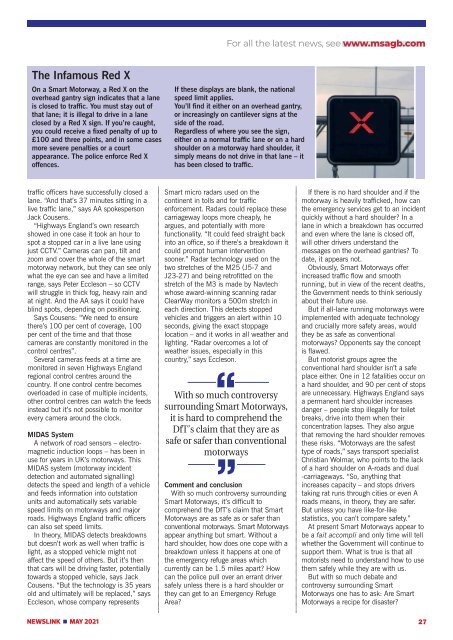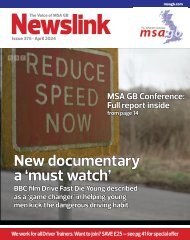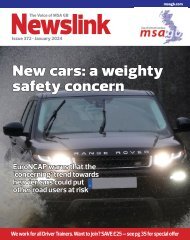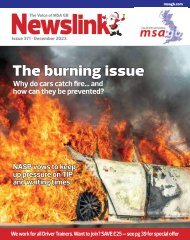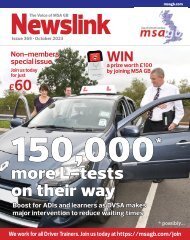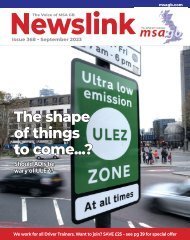Newslink May
Motor Schools Association of Great Britain, driving instructors, ADIs, road safety
Motor Schools Association of Great Britain, driving instructors, ADIs, road safety
You also want an ePaper? Increase the reach of your titles
YUMPU automatically turns print PDFs into web optimized ePapers that Google loves.
For all the latest news, see www.msagb.com<br />
The Infamous Red X<br />
On a Smart Motorway, a Red X on the<br />
overhead gantry sign indicates that a lane<br />
is closed to traffic. You must stay out of<br />
that lane; it is illegal to drive in a lane<br />
closed by a Red X sign. If you’re caught,<br />
you could receive a fixed penalty of up to<br />
£100 and three points, and in some cases<br />
more severe penalties or a court<br />
appearance. The police enforce Red X<br />
offences.<br />
If these displays are blank, the national<br />
speed limit applies.<br />
You’ll find it either on an overhead gantry,<br />
or increasingly on cantilever signs at the<br />
side of the road.<br />
Regardless of where you see the sign,<br />
either on a normal traffic lane or on a hard<br />
shoulder on a motorway hard shoulder, it<br />
simply means do not drive in that lane – it<br />
has been closed to traffic.<br />
traffic officers have successfully closed a<br />
lane. “And that’s 37 minutes sitting in a<br />
live traffic lane,” says AA spokesperson<br />
Jack Cousens.<br />
“Highways England’s own research<br />
showed in one case it took an hour to<br />
spot a stopped car in a live lane using<br />
just CCTV.” Cameras can pan, tilt and<br />
zoom and cover the whole of the smart<br />
motorway network, but they can see only<br />
what the eye can see and have a limited<br />
range, says Peter Eccleson – so CCTV<br />
will struggle in thick fog, heavy rain and<br />
at night. And the AA says it could have<br />
blind spots, depending on positioning.<br />
Says Cousens: “We need to ensure<br />
there’s 100 per cent of coverage, 100<br />
per cent of the time and that those<br />
cameras are constantly monitored in the<br />
control centres”.<br />
Several cameras feeds at a time are<br />
monitored in seven Highways England<br />
regional control centres around the<br />
country. If one control centre becomes<br />
overloaded in case of multiple incidents,<br />
other control centres can watch the feeds<br />
instead but it’s not possible to monitor<br />
every camera around the clock.<br />
MIDAS System<br />
A network of road sensors – electromagnetic<br />
induction loops – has been in<br />
use for years in UK’s motorways. This<br />
MIDAS system (motorway incident<br />
detection and automated signalling)<br />
detects the speed and length of a vehicle<br />
and feeds information into outstation<br />
units and automatically sets variable<br />
speed limits on motorways and major<br />
roads. Highways England traffic officers<br />
can also set speed limits.<br />
In theory, MIDAS detects breakdowns<br />
but doesn’t work as well when traffic is<br />
light, as a stopped vehicle might not<br />
affect the speed of others. But it’s then<br />
that cars will be driving faster, potentially<br />
towards a stopped vehicle, says Jack<br />
Cousens. “But the technology is 35 years<br />
old and ultimately will be replaced,” says<br />
Eccleson, whose company represents<br />
Smart micro radars used on the<br />
continent in tolls and for traffic<br />
enforcement. Radars could replace these<br />
carriageway loops more cheaply, he<br />
argues, and potentially with more<br />
functionality. “It could feed straight back<br />
into an office, so if there’s a breakdown it<br />
could prompt human intervention<br />
sooner.” Radar technology used on the<br />
two stretches of the M25 (J5-7 and<br />
J23-27) and being retrofitted on the<br />
stretch of the M3 is made by Navtech<br />
whose award-winning scanning radar<br />
ClearWay monitors a 500m stretch in<br />
each direction. This detects stopped<br />
vehicles and triggers an alert within 10<br />
seconds, giving the exact stoppage<br />
location – and it works in all weather and<br />
lighting. “Radar overcomes a lot of<br />
weather issues, especially in this<br />
country,” says Eccleson.<br />
‘‘<br />
With so much controversy<br />
surrounding Smart Motorways,<br />
it is hard to comprehend the<br />
DfT’s claim that they are as<br />
safe or safer than conventional<br />
motorways<br />
‘‘<br />
Comment and conclusion<br />
With so much controversy surrounding<br />
Smart Motorways, it’s difficult to<br />
comprehend the DfT’s claim that Smart<br />
Motorways are as safe as or safer than<br />
conventional motorways. Smart Motorways<br />
appear anything but smart. Without a<br />
hard shoulder, how does one cope with a<br />
breakdown unless it happens at one of<br />
the emergency refuge areas which<br />
currently can be 1.5 miles apart? How<br />
can the police pull over an errant driver<br />
safely unless there is a hard shoulder or<br />
they can get to an Emergency Refuge<br />
Area?<br />
If there is no hard shoulder and if the<br />
motorway is heavily trafficked, how can<br />
the emergency services get to an incident<br />
quickly without a hard shoulder? In a<br />
lane in which a breakdown has occurred<br />
and even where the lane is closed off,<br />
will other drivers understand the<br />
messages on the overhead gantries? To<br />
date, it appears not.<br />
Obviously, Smart Motorways offer<br />
increased traffic flow and smooth<br />
running, but in view of the recent deaths,<br />
the Government needs to think seriously<br />
about their future use.<br />
But if all-lane running motorways were<br />
implemented with adequate technology<br />
and crucially more safety areas, would<br />
they be as safe as conventional<br />
motorways? Opponents say the concept<br />
is flawed.<br />
But motorist groups agree the<br />
conventional hard shoulder isn’t a safe<br />
place either. One in 12 fatalities occur on<br />
a hard shoulder, and 90 per cent of stops<br />
are unnecessary. Highways England says<br />
a permanent hard shoulder increases<br />
danger – people stop illegally for toilet<br />
breaks, drive into them when their<br />
concentration lapses. They also argue<br />
that removing the hard shoulder removes<br />
these risks. “Motorways are the safest<br />
type of roads,” says transport specialist<br />
Christian Wolmar, who points to the lack<br />
of a hard shoulder on A-roads and dual<br />
-carriageways. “So, anything that<br />
increases capacity – and stops drivers<br />
taking rat runs through cities or even A<br />
roads means, in theory, they are safer.<br />
But unless you have like-for-like<br />
statistics, you can’t compare safety.”<br />
At present Smart Motorways appear to<br />
be a fait accompli and only time will tell<br />
whether the Government will continue to<br />
support them. What is true is that all<br />
motorists need to understand how to use<br />
them safely while they are with us.<br />
But with so much debate and<br />
controversy surrounding Smart<br />
Motorways one has to ask: Are Smart<br />
Motorways a recipe for disaster?<br />
NEWSLINK n MAY 2021<br />
27


